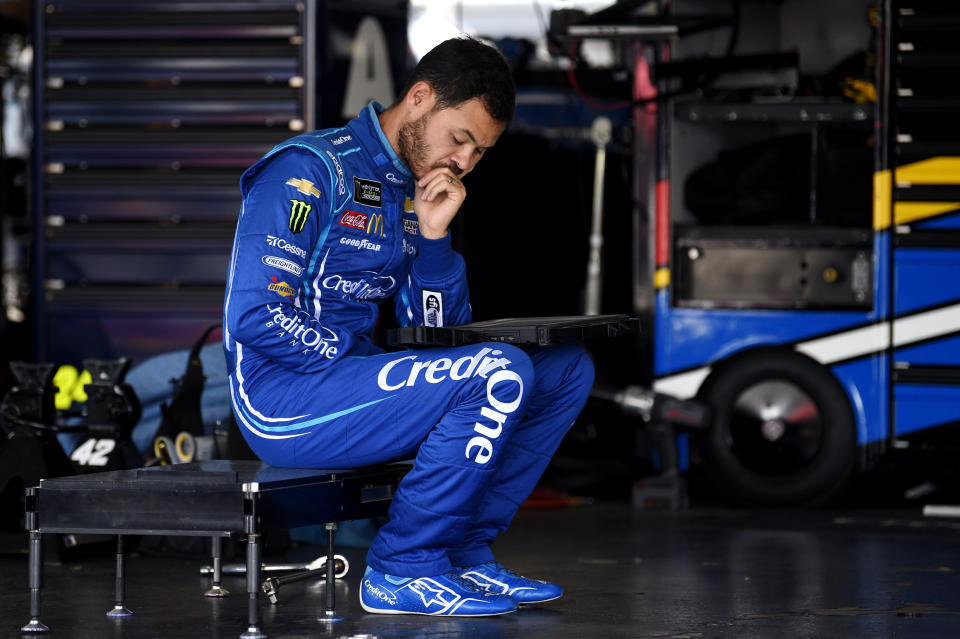Kyle Larson's racial slur drags NASCAR backward
Sports has all but stopped in the face of the coronavirus pandemic. No games. No fans. No revenue.
About the only glimmer of hope out there was NASCAR. The stock car circuit certainly would have preferred running its traditional season, but faced with that impossibility, it has been staging simulated online events, with top drivers, on the iRacing platform.
It wasn’t the same, but it also wasn’t bad. In its own way, it was unique and a bit addictive. Weekly viewership has topped 1 million on Fox and FS1. It actually served as an opportunity for targeted growth for a sports league plagued by troublesome demographic trends and the departure of star drivers.
No one thought video game racing was going to turn NASCAR into the NFL — or even the NASCAR of a decade ago. It stood to reason, however, that the nature of the platform might bring in some new fans who generally trend toward eSports. Maybe some would stick around.
Every little bit helps when you’ve been dying on the vine like NASCAR — dwindling attendance, sponsorship revenue and television ratings.
Then, right in the middle of Sunday's race, came Kyle Larson’s ugly, inexcusable use of a racial slur.
Larson has torched his career. He also delivered a body blow to NASCAR itself, which for years has sought to reach beyond its traditional fan base and driver pool while presenting its reality as a far more diverse and welcoming place than the old stereotypes suggest.
Only here was that stereotype again, confirming the worst suspicions of skeptics, critics and those not predisposed to even give it a chance.
Larson was fired Tuesday by Chip Ganassi Racing. There is no place for this and unlike professional team sports, a driver can’t blend in on some big roster. NASCAR is almost wholly reliant on sponsors. The moment a driver is deemed too toxic for business, he's done.
Where Larson goes from here is one thing (it’s on him to repair his image if he is to return).
Where NASCAR goes is the bigger issue.

The sport remains a lot of fun to follow but it isn’t as popular as it used to be. Its traditional fan base is shrinking. New customers in new markets haven’t emerged to replace them.
Fewer fans, fewer advertisers. Entering what will undoubtedly be a period of economic difficulty, NASCAR, like every other sport, is in no position to lose more of either.
You need to give corporate partners a reason to stay, especially in downtimes. Larson gave them a reason to leave.
NASCAR has tried to soften its image and make itself more accessible to all sexes, ethnicities and ages.
More could and will be done, but it has staged outreach in urban areas and tried to lure in young fans. Pre-race concerts now go past just country acts. Race weekends are marketed as rollicking parties. Grandstand bleachers have been reconfigured with luxury boxes and party decks.
It’s likewise banned (officially) the flying of Confederate flags, which while still flying at tracks is an image many people from all races find offensive, hateful and unwelcoming. It even offered a trade-in program, replacing them with an American flag.
Some of this has worked. Some less so. There have been plenty of missteps as well.
Regardless, it hasn’t been enough for NASCAR’s bottom line. It’s a battle, especially when races are a bit long for modern attention spans and there isn’t a Dale Earnhardt (Sr. or Jr.) at the start line.
NASCAR’s challenge is finding new fans to give it a fresh look. While it has a sad history of intolerance, its days as some monolith ended long ago. No, it isn’t perfect, but crews and teams are more diverse. There are half-million-dollar RVs in the infield right next to humble tents. There are fans from the towers of Manhattan and the mountains of North Carolina, twenty-somethings cheering alongside the AARP crowd.
A fast car is a fast car, it appeals to more than just one race or gender or age or socioeconomic group.
The circuit’s Drive for Diversity program has tried to create opportunities for drivers who are women and/or of color. That includes Kyle Larson, who grew up in Northern California to a Japanese American mother.
Larson, 27, was supposed to be part of the changing face, and perhaps fortunes, of NASCAR — young and talented, daring and diverse.
Instead he dragged the sport backward.
NASCAR’s initiatives can only do so much to change perceptions when dealing with a wave of headlines like this.
Same old NASCAR. Same old sport to ignore. Or so it goes.
That kind of damage lingers far beyond the news cycles of apologies and suspensions. It's NASCAR’s old, worst stereotype being reaffirmed, just as it was finding a flash of iRacing positivity to perhaps push through the pandemic.
More from Yahoo Sports:

